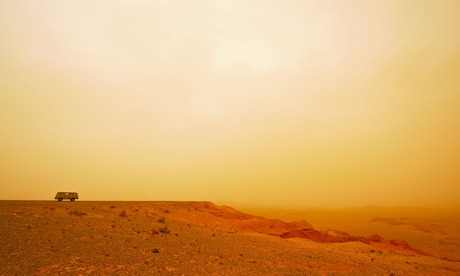

BLOG
Courtesy of The Guardian, a report on how one resource-rich country is riding high economically but a battle is brewing for water between people, mining and agriculture:
 The Gobi desert. The Mongolian mining boom may promise great things for economy but chronic water stress is a cause for concern.
The Gobi desert. The Mongolian mining boom may promise great things for economy but chronic water stress is a cause for concern.The sight of foreign faces in Ulan Bator used to turn heads. Now they are two-a-penny as the once remote Mongolian capital fast becomes a hotspot for international investors. The main draw is the country’s rich mineral deposits, which, if successfully exploited, could see the national economy more than double over the next two decades.
Impinging on that rosy picture, however, is the tricky question of water availability. The central Asian country suffers from extremes in seasonal runoff, local water stress and chronic deficits.
“In the coming two decades, water demand is expected to triple even as water suppliers are shrinking”, states 2030 WRG, which predicts a 244,000 m3 per day water deficit by the end of the next decade. The link between water stress and mineral exploitation is where much of the concern currently lies. A substantial proportion of Mongolia‘s copper and gold reserves happen to be found in its driest spot: South Gobi. Rainfall in the desert area ranges between zero and a measly 50mm per year.
A range of potential infrastructure options is on the table. One of the most ambitious would see the country pump in water via a 600km pipeline from the Orphon River in the country’s north. At $550m (£328.7m), the project’s price tag puts its viability in doubt. Desalination represents another outside option. However, question marks hang over whether landlocked Mongolia has the deep pockets or indeed the hydrological conditions to make it happen.
For the moment, the onus is on mining companies making their operations as water efficient as possible. The World Bank-backed International Financial Corporation, for example, recently initiated a water management programme with most of the major mining operators in South Gobi. Among its early outputs is a pilot training package for companies on best practices.
“There’s a lot to be shared and gained by visiting each another’s projects and setting among ourselves the height of each other’s bar”, said Mark Newby, environment manager for Rio Tinto’s huge Oyu Tolgoi copper-and-gold mine in South Gobi.
Oyu Tolgoi, which came on stream in 2013, is touted as a benchmark for the industry. The $6.2bn (£3.7bn) project draws all its water from a 560km2 subterranean aquifer, located about 400m below the desert surface. Over two-thirds (70%) of its water use is reclaimed, recycled and then reused. High efficiency tailings thickeners and reclaim processes account for the largest proportion of water savings at the mine, which operates a zero-water discharge policy.
From the “get-go”, the company realised water efficiency would be make or break for the project, said Newby: “It’s a fossil resource and if it’s to be used up unreasonably quickly, then that just ends the mine life earlier”. The mine is expected to use up one fifth of the aquifer’s 6.8bn cubic metres during its projected 27-year lifespan, according to Rio Tinto’s own calculations.
Campaign groups have claimed that Oyu Tolgoi could jeopardise local water availability. Rio Tinto maintains that an impermeable layer above its main aquifer separates the brackish water that it extracts from the cleaner, shallower water on which local communities depend. The company has also installed sensors in over 30 wells in the area and has trained local herders in their use, promising them real-time data on water levels.
Local concerns surrounding Rio Tinto’s mine reveal an additional concern around mineral extraction’s impact on agricultural. Mongolia’s Southern and Central Zones occupy terrain traditionally used by nomadic herdsmen. Diverting already scarce water resources to mining could imperil their livelihoods, analysts warn. Similarly, water scarcity threatens the production of irrigated food crops, the problem is especially in the Central Zone, which provides Ulan Bator with much of its food supplies.
Shifting agricultural production to the country’s east and west regions, where water resources are more plentiful, represents one potential solution. Again, a more obvious and more immediate answer is to promote water efficiency. Among 2030 WRG’s early recommendations is an increase in the use of drip and sprinkler irrigation, coupled with improvements in fertiliser balance and pest control.
The most pressing water-related headache facing Mongolia relates to Ulan Bator itself. With around 1.3 million people, the capital city is home to over two-fifths of the total population. The city’s infrastructure is already under huge strain, with access to clean water and sanitation facilities among the chief problems. Rural-urban migration is set to exacerbate these further in the coming years.
“In a high growth scenario, Ulan Bator could potentially run out of water between 2015 and 2021, which is not that far off”, warned Alex Mung, head of the World Economic Forum’s Water Initiative and an adviser to 2030 WRG.
Mung sees a key role for private water companies in terms of knowledge sharing and the co-financing of vital water infrastructure. He points to the example of South Africa, where municipal governments are offering private operators financial incentives to reduce leakages. The companies are remunerated according to their ability to stem water losses.
The traditional availability of water means many national firms have yet to grasp the urgency of the problem, said Mung. That will require a concerted awareness-raising effort. Learning to collaborate within the business sector and with government is another imperative, he argued: “The more we can do together, the better it will be for everyone and overall for Mongolia.”